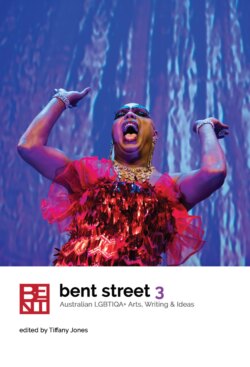Читать книгу Bent Street 3 - Tiffany Jones - Страница 8
На сайте Литреса книга снята с продажи.
INTRODUCTION TIFFANY JONES
ОглавлениеWelcome back to Bent Street, a twisted tapestry of our time. In 2019 we have weavers well-known and new, spooling glittering gossamers into our web. We maintain a strong loom of redolent writers, poignant poets, enraged essayists and unflinching photographers. Nevertheless, for the first time we are now interlaced with gallant graphic novelists, defiant digital artists, and inspiring installation-artists. Bent Street 3 stays focussed on its role as an ‘annual’ publication: featuring works from LGBTIQA+ and allied creators in 2019, themes arising from 2019, and the view backwards and forwards as at 2019.
Three thicker threads wend their way through the thinner filaments of this woven work. The first thread woven through our tapestry belongs to Australia’s First Nations peoples: the strengthening of public displays of Aboriginal and Torres Strait Islander LGBTIQA+ pride and visibility was a major 2019 theme. From Koori Gras in February (see Jamie James’ cover photo of Nova Gina, and Black Nulla Koori Gras Carriageworks photo essay); to Peter Waples-Crowe’s Koorie Heritage Trust art exploring Ngarigo and queer identity showing in Melbourne in May. Indigenous Queer Studies academic, Andrew Farrell, a Wodi Wodi descendant from Jerrinja Aboriginal community on the South Coast of NSW, describes their development of world-first Aboriginal Queer University Units. Bee Cruse, born and bred on Cabrogal country (a clan within the Darug nation), whose family comes from the Gomeroi, Wiradjuri and Monaroo-Yuin peoples of NSW) describes a first experience of Koori Gras which brought deeper connections to family. Mandy Henningham discusses complications to Queer Indigenous research.
The second thread belongs to times of crisis: LGBTIQA+ people and our allies respond to ruination of our planet in the climate crisis and other types of crises. Michelle Bishop, a Gamilaroi woman from Western New South Wales (NSW) living on Dharawal Country south of Sydney, shares a poem about the devastatingly uncivilised impacts of so-called ‘civilisation’. Xavier, a Black Australian university student not yet out to family and inspired by the Extinction Rebellion climate protection movement, shares a triptych of poems ‘Colour’s end’ discussing the political and existential threats to the environment, queerness and people of colour. Jason Li writes of the crisis in Hong Kong, and how LGBTIQA+ people shape resistance cultures. Ayman Kaake’s refugee-inspired photo-stories explore travelling by boat to Australia when one’s own home is untenable. Lionel Wright watches his Mexican-American boyfriend’s family crisis unfold under Trump Administration immigration clamp-downs. Stephanie Amir discusses feeling on the fringes whilst navigating the discovery of disabilities. The Year in Queer includes Randy Rainbow’s cabaret covers and Toddrick Hall’s power pop as hyper-queer snap-backs to various crises.
A third strand is the battle for religious accommodation of LGBTIQA+ people and women, as the line between freedom of religion and discrimination against LGBTIQA+ people was ferociously debated this year. Academics including Timothy Jones and Jennifer Power discuss the best pathways forward around Victorian and broader moves to ban LGBT conversion therapies. Clare Monagle offers a personal account of the fallout from the fall of Cardinal Pell in ‘The Church Herself’. Geoff Allshorn discusses gay and atheist liberations. Jocelyn Deane’s ‘Trading Saints’ triptych explores devotions, rituals and sacrifices. Young artist Hannah Buttsworth shares three artworks featured in the Art Express collection ‘Renascence’; representing a growing awareness of identity while within a condemning religious environment and the catharsis of being oneself.
Bent Street 3 has many other cords curving through it from gender to romance. Wrap yourself in its fabric as a source of cover in battles, comfort in crisis, and the warmth of community …
Tiffany Jones—Editor
1 November 2019
